Copyright ©1999 by Dennis Báthory-Kitsz
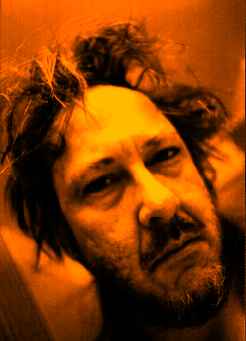
Should I ever write an autobiography, I would adopt Salieri's final line from Amadeus as its title: I am The Patron Saint of Mediocrities. That's because I have grown excited over the breadth and depth of composition in recent years, while at the same time perhaps confused and disturbed about the music I have made.
I was a young composer with great certainty, convinced I would create sounds never before heard, music that would stun. I took the aging Stravinsky and the shocking Cage and the emerging Zappa as personal mentors, as if I could make them my private teachers. It was a wonderful, romantic, ignorant, self-preserving bravado.
In fact, though, I'm turning 50 next month. I still get those tempting posters in the mail (and now by email) that say 'opportunities for young composers' -- and I still look at them! I look at them before I remember the truth, for nothing inspires a crisis of confidence like being in mid-career!
I'm committed to eclecticism, if that's not oxymoronic. 500 pieces and more have spilled from my pen and my computer, yet I'm still finding my way. I hardly have a style I can proselytize about, beyond a few consistencies I've picked out and named. I have yet to mature, I suppose, which may explain why it's taken me three decades to receive an invitation to speak about my music at a respectable institution.
And now I find not one but two generations of composers younger than I am who are writing. I wonder what I had to say, or still have to say. In 1968, I asked one of my instructors why he didn't compose. Because, he said, there were enough mediocre composers. After these years of work, I think I understand what he meant. The Patron Saint of Mediocrities. Forgetfulness is not a wonderful thing.
But if I'm a saint, I'm certainly one without humility. So I'm going to talk about me. My history. My music. What I do today. Radio and Internet. Complaints and contritions.
I grew up in the rotting snow of the Great Musical Experiments, just a little late to be part of a legendary era. I was only 8 when Stockhausen was recording his remarkable Gesang der Jünglinge, 14 when Terry Riley was creating minimalism out of the thin air, fulfilling Schoenberg's prediction.
At 19, I was scribbling schematics and building analog synthesizers out of discarded components and salvaged telephone wires and cutting up tin cans for keys, even as beautiful Moogs and Arps were making their debuts. A few years later, I had just begun my appearances at the New York Avant-Garde Festivals as they were showing their entropy, as they prepared to fall into oblivion after an unsettling autumn in exile near Boston, with Charlotte Moorman's tears streaming.
But in the beginning I knew none of the compositional world, and was learning slowly, as in a dream of surprises, of falling, of panic, and of awakening.
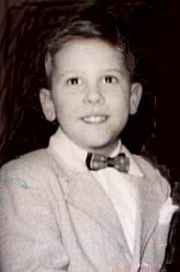
In the 1950s, I was also a child among the hopeful suburban poor, during my family's attempt at upward mobility toward the American dream-state. It didn't quite take with me. We did practical stuff, and our reward every few months was a night at the Lichee Chinese restaurant with its snapping white napkins and lukewarm white rice. Music certainly wasn't part of the plan, the family plan, with me the first among our clan to attend college. I would be The Physicist, perhaps after a tour at West Point.
So my musical discoveries were necessarily my own, made in private, away from disapproval. I was an adult before I learned most of these discoveries had already been made.
My musical experiences as a young person will explain what I mean. I had no music as a child, really, except for background radio now and then.
| Victimae Paschali Laudes | 1961, age 12, grade 7 |
| Duke of Earl | 1962, age 13, grade 8 |
| Siegfried's Funeral March | 1963, age 14, grade 9 |
| Bass clarinet & a tone poem | 1964, age 15, grade 10 |
| Rite of Spring and Ascension | 1965, age 16, grade 11 |
| Gesang der Jünglinge | 1966, age 17, grade 12 |
Two years in a Catholic school gave me a sense of Gregorian Chant, back in 1961 before the reforms that brought the English language and bad quasi-folk guitar music to the chancel. But in 1962 I discovered rock 'n' roll. These were the Duke of Earl and Chapel of Love and Blue Moon days, just before the Beatles clambered onto American shores -- though my fascination with rock had already evaporated in favor of a mysterious sound I had discovered during an accidental button-mashing on our Grundig radio.
Captured by these orchestral noises -- it was Siegfried's Funeral March--I wanted to invent more like them. I secretly sat surrounded by encyclopedias, trying to make sense of the paltry examples of written musical language, eventually braving the eyes and attitude of the band instructor to ask to learn an instrument: a bass clarinet it was. The code unlocked itself, and I started to write. In a few months I produced a 40-page score for 17 instruments, right about the time I discovered Stravinsky's Rite of Spring and just at the cusp of hearing my first jazz: Coltrane's Ascension.
I was ablaze. I ate and drank sounds. And then I purchased a strange foreign record. It was by a German composer with an unpronounceable name, and the record was called Gesang der Jünglinge.
My life changed. The physicist I was to be slumped his shoulders and left my soul. At Rutgers University, I floated through two years of mathematics and physics and then French and psychology, finally abandoning my family's dreams and capitulating to musical composition. It wanted to damn me forever, and it did.
Music terribly upset my practical household -- as decades later it still does -- but I studied and struggled through proficiency tests (Being a player was essential in those days, but I really wasn't one, having learned instruments as best I could in my mid-teens). A year before I composed my first electronic composition, I entered the music department at Rutgers University, with my eyes sparkling with ideas and readiness.
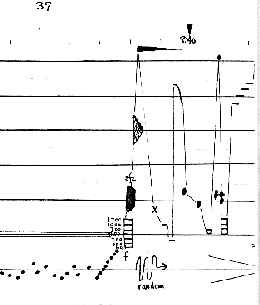
I arrived at the chairman's office, scores in hand. He took one disdainful look at my hair and my hope and almost withered the life out of both of us. "Mr. Kitsch, our undergraduates do not compose." As far as they were concerned, for the next three years, I didn't compose. But I was composing.
1969 Composition for Tape & Soloists in the 1985 premiere
My instructors were Sherman, Picker, Strainchamps, Walter, Moevs -- minor figures all, and not really my teachers. My university experience was a disaster. These instructors were burned out, arrogant, and definitely part of the talk-to-the-wall, pre-enlightened Sixties. I was forced to be self-taught, learning to read scores on the bus during a daily 90-minute commute to the University. It was then I imagined myself being taught by the great composers, and by my chosen mentors, Stravinsky, Cage, and Zappa. I was really blundering, but some of the blundering was good, some of the bravado worthwhile.
The status outside my life -- about which I was oblivious -- was acoustic research, theoretical proposals, style wars between serialism and tonality, electronics that were moving from handmade black boxes to consumer products, and a kind of artistic decay. It was 'that Funny Era' -- post-Fluxus, late avant-garde, creative moldiness that gave rise to the flaccid New Romanticism.
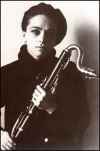
I felt out of time making those already-discovered discoveries. I -- we, it turns out -- were always catching up. I say 'we' because I recently spoke with composer Mary Jane Leach, who is just my age. She agrees that perhaps our mid-placed generation had never felt a proper balance between groundbreaking originality and the synthesis of ideas, and was often unwilling to plunge into the emerging realm of electroacoustics because it seemed more research and programming than musical composition.
The era of sonic experimentation was softening anyway, and we found ourselves concerned with a newfound emotional or ritualistic or even simple communicative character in place of a purity of theory. Experimentation, if that's what it was, had lost its fascination since all the hypotheses appeared to have been proposed. Stockhausen had once and for all demolished atoms in favor of formants -- and we were too old to include chickens or chainsaws in our performances.

Interestingly, Clarence Barlow -- a leader in theoretical ideas that often dismissed intuitive musicality, at least on the surface -- has begun speaking about something similar recently, calling it a return of quality in music. It's led him to finish a decades-old piano concerto, and to produce a series of self-mocking compositions and essays. On our radio show, Kalvos & Damian's New Music Bazaar, I've called this the New Golden Age of Music. This idea makes me happy in my mudpuddle of eclecticism. Golden Ages are great times.
Beyond living in the shadow of the great avant-garde, I possessed a hungry curiosity that also contributed to a certain lack of focus. Pieces I have written include 133 chamber works from solo piano works through a triple string quartet; 44 large ensemble works encompassing two concertos and five symphonies; 107 vocal works from cabaret to chamber opera; 77 interactive creations including electroacoustic works, sound environments and performance pieces; 38 arrangements; and 100 or so minor sketches, studies, and experiments.
| 27 Sonatas & solos 30 Duos & duets 15 Trios 6 Quartets 4 Quintets 2 Sextets 1 Triple quartet 48 Miscellaneous chamber works | 133 chamber works |
| 10 Fugues, inventions & sets of variations 5 Symphonies 2 Concertos 7 Marches 20 Miscellaneous large ensemble works | 44 large ensemble works |
| 3 Sets of incidental music or theatre 3 Shows 1 Mass 1 Chamber opera 22 Miscellaneous choral works 77 Songs | 107 vocal works |
| 28 Performances pieces 40 Electronic/electroacoustic pieces 9 Sound environments/installations | 77 interactive works |
| 38 Arrangements 121 Minor sketches and studies | 159 other works |
These are compositions in different styles and approaches -- eclecticism abundant. It's been said that composers today are convinced their work is eclectic because it adopts styles and techniques from all the world's cultures. I don't think I have time enough to do wholesale stylistic sponging, so my own eclecticism largely explores the realm of 'composed' music in the Western tradition, as well as experiments and tests and studies and improvisations and aleatory that contribute to it. What are its limits? What are the results? Some selected titles and orchestrations include:
|
Composition for Tape & Soloists (voice, clarinet, and tape, 1969) (15:00) Exequy on the Death of Igor Stravinsky (wind ensemble, 1971) (6:00) Concerto for Piano, Winds & Electric Bass (1972) (15:00) Variations (piano, 1972) (6:00) String Quartet (1973) (15:00) i cried in the sun aïda (voices and processing, 1973) (7:00) Network C/R (dancer and interactive electronic harness, 1975) (20:00) Somnambula (recorder and surround tape, 1975) (90:00) Teething Rings (ensemble of criers, 1975) (6:00) Cy-Gît (dancer, singers, players, and tape, 1976) (10:00) Lithuanian Liniment March (band or piano five hands, 1976) (3:00) Stoneworld/Grey (costumed dancers and ocarinas, 1977) (15:00) Plasm over ocean (chamber opera with original instruments, 1977) (25:00) Triple Quartet (three string quartets, 1977) (45:00) Car Horn Symphony No. 1 (1978) (5:00) Missa da Camera (singers and small instruments, 1978) (25:00) Not Vermont Hardware (three players, typewriters, bananas, 1979) (15:00) Ash Wednesday (singers and instrumental ensemble, 1983) (25:00) The Two-Minute Sneeze (woodwind trio, 1985) (3:00) Echo (performance work, computers, original instruments, 1985) (55:00) Windows on the Moon (solo cello, 1986) (15:00) Mantra Canon (Symphony No. 3) (orchestra, chorus, etc., 1986) (25:00) Beepers (cabaret, 1986) (25:00) Rough Edges (solo piano, 1987) (25:00) Pianaroll (piano and tape, 1988) (10:00) Car Horn Symphony No. 2 (1988) (5:00) Variations on Amanda (violin, two cellos, harpsichord, 1989) (15:00) Northern Lights ... Seeking Sasquatch (orchestra, 1989) (10:00) Csárdás (piano, 1989) (9:00) A Time Machine (small ensemble, singer, computers, 1990) (45:00) Yççuré (two chamber orchestras, 1990) (15:00) Honey & Hops (solo clarinet, 1990) (7:00) Mouth Piece (Peace) (singers and instruments, 1991) (25:00) Softening Cries (orchestra, 1991) (25:00) Thièle (quarter-tone solo violin, 1991) (15:00) Binky Plays Marbles (viola and double-bass, 1992) (15:00) The Moon (solo voice, 1992) (5:00) Llama Butter (tuba and tape, 1993) (25:00) Emerald Canticles, Below (violin, clarinet, cello, piano, 1993) (15:00) Hypertunes, Baby (voice and tape, 1994) (10:00) Build, Make, Do (clarinet, marimba, keyboards, cello, 1994) (15:00) Hang Time (timpani and orchestra, 1995) (10:00) Hoots & Honks (string quartet, 1996) (20:00) zéyu, quânh, sweeh (sound playback, 1996) (5:00) Detritus of Mating (sound environment, 1997) (65:00) Into the Morning Rain (2 bass clarinets, violin, cello, drums, 1998) (8:00) |
So, other than cultivating shallow mediocrity and conducting experiments without breakthroughs, what have I been doing with this mélange? What does this eclectic opus mean?
A few years ago, I set out to answer that question. I was sinking in a sea of scores and tapes. Because of the way I composed, I had no reference points in style or theory. I composed out of curiosity, composed to order, composed for friends, composed for myself, created little studies and electronic novelties. I composed 'on the cheap' as well -- little equipment, few instruments to speak of, no university haven and -- often in my own view during periods of compositional post-partum depression -- no talent.
I was also without performances that I did not organize myself. With the exception of a minor choral piece and a wind trio, nothing of mine was performed except by me or under my own direction from 1964 to 1988. Certainly my move from the New York area to Vermont in 1978 didn't help.
Living in oblivion forces one into long periods of reflection. I wrote about my action -- not process, really, but action -- of composing in a letter to a friend. It sounds almost mystical in the 1988 letter. It gave me a chance to find myself a little, and I revised the letter into an essay a few years later.
1971 Exequy on the Death of Igor Stravinsky in the 1992 premiere
I don't know how it comes, or why, or how the ideas take shape. The experience is entirely non-verbal, and the translation is impossible. It begins with wild, wide alternations between elation and depression, and manifests itself as musically infected mood swings, an extreme disaffection with music itself -- all music. I turn off the radio, or complain about it when it's on. I pick unhappily through my collection of recordings, hoping I'll find something vitalizing, but can't.
No, all music becomes affected, pale, empty, worthless, even abrasive. Bach becomes a prig and Mozart a dandy, Mahler a rooting pig, Beethoven a schizophrenic jackal, Bartók a clown, Stravinsky a bumbling dilettante. Rock and roll sounds like junk piles being torn through by sweating dogs. I run for the radio and snap it off.
I hate sounds, I fume ... and I begin to pace. The pacing becomes frenetic, and I wipe my right hand over my brow and through my hair. Then I pull out music paper or load the composition software and abandon everything else -- cooking, repairing, writing words, gardening, even (until it becomes unbearable) biological demands -- to write.
I push buttons or sharpen pencils to calm myself. I am tormented by ugly, crashing jumbles of sound all intoning at once in my mind's ear and the raw materials and ruined recyclings of sound begin to erect themselves -- out of my control it sometimes seems -- into a structure, an architectural form. But the screen glares back at me and I fuss with its colors. Even the comfort of music paper is wrong, without the right number of lines, or it's too yellow or too green or too shiny, or it's long when it should be tall. I disgustedly choose the best and sketch the clefs first and the instrumentation with them; everything is composed in full score, the way it will be heard ... no piano sketches to be expanded later. The notes fall from the hands. and the piece takes shape. It has been composing in my head over the past (two) (three) (days) (weeks) (months), and I've been hearing it, I know, but the shape doesn't come until the dissatisfaction and room pacing begin. Even worse -- and this is so maddening -- I can never find the root of it! The piece is at work before I know where it came from, and the inventions and developments take place as I am preparing to write.
From the onset of dissatisfaction to the initial writing can be less than a few hours, and the only time I could reconstruct the process was when my back was injured and I was drugged. A piece began in my mind as a fragment of melody, and in a way I could actually hear myself coax the fragment to play through. So play itself out it did, but it would regularly withdraw and reroute itself along a better path, like a rat in a maze, until it was written quite well, thoroughly ... but not to the end. Harmonies and counterpoints would begin to arise, or perhaps I would consider them as the melody was being drawn out, and these would come quite literally into an aural focus. Missing connections or bridges would be built as much by my pencil as my mental ear. It was automatic writing sometimes, but if the architecture looked wrong I would erase it and start again. Finally, the rest of the piece assembled itself as I struggled to keep up with my pencil.
So, once it has begun, I compose, night and day, with little regard for anyone or anything around me (including other music playing) until the pencil catches up with the thoughts. Sometimes that catching up is at the end of the piece, as with the Thièle, written in three days; at other times, such as Rough Edges, it will get stuck at a transition without being able to build the bridge to a new area, which itself may already be composed. With Csárdás, the first page jumped out but the rest crumbled to nothing and remained rubble until I built a new, more worthwhile musical shape.
Each piece is its own self, but the process always seems the same. Even with short arrangements, such as Lush Life, the taking over of my other minds by the non-verbal composer mind is complete and astounding. Music was playing, conversation going on, yet only the sound in my mind took over, the notes poured out, and the piece was finished.
But inspiration. I've never understood inspiration. Is it when a tune jumps into your head from nowhere? No, then it's never happened to me. More, it's like something growing in the distance, but it's blurry. As I concentrate, it comes into focus, still growing. No bolts of lightning, no voice of God. The form is there, like a growing plant takes the form of the adult within days of its germination -- and the genetic material and all the biological instructions for the adult have been there in the seed, waiting for the moment of fertility.
But no analogy works. The reality is this: I dream -- daydream is better -- and hear fleeting sounds; sometimes they are notes building into tunes, sometimes they are counterpoints playing against each other, sometimes only textures, sometimes verbal ideas translating into another language, but it's seldom the same as that, rather being drawn from some musical image area in my head which you can only see if you imagine me working as I look ahead, down, ahead, down, brushing my hand through my hair, burbling aloud bits of sound, then jumping up, pacing, pacing, pacing, then eating, and again sitting and brushing my hand. That's what you would see if you could watch: I would appear something like an idiot. It might be in slow motion, I don't know, because time goes by so oddly when I compose ... first it's 9 am, then it's 3 pm, and yet I don't know that time has passed.

The day Stravinsky died, a day in April 1971, I heard the news on the radio early that morning. I began to write Exequy for wind ensemble and recall saying briefly about having to write, Stravinsky died, I just heard, let me be for a while. The music was finished, and it felt like, perhaps, an hour, but a day had evanesced into a few pages of pencil-scratch.
So it is a kind of possession, being possessed by the music, possessed by the drive, the sound. It happens for me so differently in writing words (or anything else that can be called "creative") that I can't make it very clear. The energy is both cerebral and physical -- physically exhausting but brain-driven.
I use a computer scoring program now, but for nearly thirty years I wrote on paper, and this is how it feels: Sometimes, when a section is being written (passive voice seems right) on paper, I am motionless except for my right hand, for an hour or more, with every muscle at attention, my left wrist curled down, my head leaning on it, close to the paper, sometimes my glasses off, a ruler waiting to line measures, my right hand speeding along until it gets writer's cramp, but me moving -- forcing -- it on and on regardless, occasionally stopping to pound my right hand with my left until it stops cramping, then going on more with tiny noteheads in groups, then stems and beams, sweeping, long phrases showing arches of pencilship, short and tight ones looking knotty, and all of it done in an inner sphere of utter silence, as if my earlids had shut out the world, like the moment before waking when the telephone rings -- nearly conscious, aware of something in the distance, but enveloped by the moment of dream (like something a friend once wrote in a poem: "you have to be awake to be living a dream"), but one out of which I am unwilling to shake myself until the spell is complete, until I am drained, or, worst of all, until I am torn from it by an invasion of a visitor, human or animal, or until the sound so joins that of the outside world that it becomes one with it and leads me out of myself, as when a great hailstorm comes up and blows and rattles and slams and claps along with the percussion and I am drawn out to breathe a sigh of relief and look back, if for only a moment or two, at the few seconds of music that have been written in the many hours I have spent silent, still, concentrating and glowing with an aura of pure sonic energy, or -- at last and gratefully -- if the music has completed itself.
The unspecified and unfocused dominated my approach, and continue to do so. Overtaken by fetishes and compulsions, I never think of pitch classes or invertible counterpoint or fractals or harmonic implications or granular synthesis unless I need to disentangle myself from a compositional confusion, to solve a peculiar puzzle of direction within a piece, to break out of an inert stretch, or to set up the propositions and develop the evidence for an experiment in sound, performance, or communication.
So the unspecified and unfocused I have not analyzed, and will not.
But during my oblivion-reflections, I did make a retrospective discovery of a style inside my music, perhaps from some experiment that worked well enough to put me inside a loop of functional feedback for my compositional processes. It was a surprise. I came to call it Expansion-Contraction Linear Modulation, if only to have a name, a conversation piece, something to tell you or the critics.
The concept is really simple. In a sense, I'm a believer in melody; my mother doesn't agree, but it's true. I like sounds that move through time in a linked way, where the movement from one to another has a sense of inevitability. I like how pitches play in the temporal sandbox together, how they change and exchange, how they create aural curves and shapes and angles. I like to follow the motion of sounds, and laugh to hear other lines coming near and crossing and dancing together. I abhor stasis, or the fiction of stasis in certain minimalist statements. I'm bored by surprises which aren't -- 'Here comes another one' as Monty Python would sing.
I supposed that doesn't make me much of a conscious or committed experimentalist. Give me a tension expressed as individual musical personalities interact, and force me to follow. Enslave me in sound. I don't sound like a scientist.
Many of us probably fit the definition of 'organized sound' acolytes. Especially if you're an electronic or electroacoustic composer, you're often fascinated by sonic building blocks, processes, techniques, precision, and occasionally 'hands-off, bits-on' music-making. You make experiments which 19th century composers might have called studies. You're also enchanted with how sounds move through time and change and make those shapes and textures. I believe in this.
I have also long been fond of early music: troubadour songs, organum, and especially the peculiar simultaneities of multi-lingual motets. The intonation systems fascinate me, as does the concern for the intricate forward action rather than stasis or verticality. The melodic turns of Bernart's Be m'an perdut are chilling, as is the interplay of lines in Ockeghem's Masses or his songs like Ma bouche rit. In contrast, melody-harmony styles and their relatives feel dull, particularly their ultimate manifestation in Mozart. It seems to me a wasted simplification, except as a kind of entertainment.
The beauty of the weave created by the interplay of lines in early music stays with me. From instrumental music to electronics, I always compose in a linked forward motion, concerned with each line within a piece, each player, each human player, and eventually the extension of that thinking, each electronic player or personality or moving constituent or trace within the music. Harmony is an incidental though inescapable result which I, without enthusiasm, have to accommodate because it's how our listeners hear. Often I have wished I could unlearn the cultural hearing of harmony in favor of lines and textures, replacing the stage with the perspective.
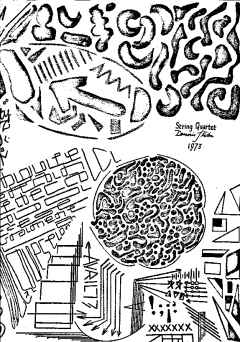
Eventually I had to resolve those conflicts in my music. Hints of that resolution appeared in my 1973 String Quartet, never performed and whose parts are now lost, in which I used graphical notation to describe paths through a cluster of colorful shapes and designs. Because the starting and ending points were the same, but the path described moved differently (including the tempi and tonality-as-an-artifact-of-texture) through the images, it effectively expanded and contracted as it modulated through the textures. It was a seminal piece for me, written as it was in avant-garde graphical notation with ground sheets and translucent overlays, yet pursuing a very linear melodic expression.
The Expansion-Contraction Linear Modulation style was first clearly heard in a 1975 composition called Cy-Gît. In it I combined the visual lines of dance with simple singing and ornamented droning lines, while a recording of John Dunstable's O Rosa Bella served as an underpinning. Each part was architecturally complete but only vertically suggested, pulling and pushing the listener in a kind of sliding horizontality.
It was a hint of where I was heading. I began to work this through in the 1977 chamber opera Plasm over ocean, in three scenes with a text by David Gunn. The handmade instruments -- an answer to yet a different question of how to produce sounds that would carry the listener forward -- included a harp, two sets of chimes, a gong, and a glass-and-maple cello, all tuned to different sets of temperaments and scale distances -- one-tenth octave linear tuning for the brass chimes, tempered whole-tone glass chimes, double-logarithmic-tuned harp, and standard fifths-tuned cello. I used the variety of temperaments to lift away any sense of or comfort from existing tonalities -- at least in the opening scene.
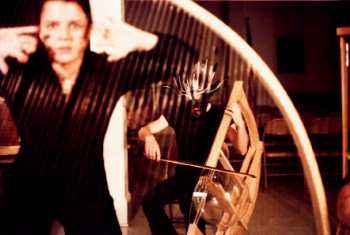
In that first scene, a typical avant-garde sound predominated. But in the second scene, a very old sound made its appearance, with each line moving in its own path between points of stability. These ancient-sounding lines alternated with the double-logarithmic harp. By the final scene, the non-standard instruments were cast aside, except for hints of Maximus's schizophrenic moments.
Scenes I from Plasm over ocean in the 1977 premiere
Scenes II from Plasm over ocean in the 1977 premiere
The first real flowering of this Expansion-Contraction Linear Modulation work was in 1978 when I composed Missa da Camera in the five traditional sections of Kyrie, Gloria, Credo, Sanctus/Benedictus and Agnus Dei. The creation of the Missa while I was sitting against a tree in the middle of New Jersey's Pine Barrens must have offered a view into my mad process of composing; I can recall little but the sitting and the results.
So it was in the Kyrie that I first let each voice float away from and toward congruity, while following its own path of both rhythm and modulation. It was motet-like and tonal, but shamelessly accepted the free rhythmicism of the vocal avant-garde.
Kyrie from Missa da Camera in the 1978 premiere
The Kyrie movement modulates back to where it started, as does the Credo. The Credo, however, is in two clear tonalities, each following a linear path, one chantlike and the other modernist melody. Underscored by the tone clusters of a 'defrocked autoharp' played with cloth mallets, the rhythmic chanting of the three men owes its inspiration to the Greek chorus as expressed by Xenakis, as the two women wind together in a sensuous counterpoint whose tonality, if heard two octaves higher, would be in perfect coordination with the harmonics of the men's chanting.
Credo from Missa da Camera in the 1978 premiere
I had not yet recognized any style inside these compositions, but was merely working out each set of ideas independently for every piece, attempting to infiltrate and subvert my audience's expectations, but not without their cooperation. (I also had fun with such pieces as Teething Rings, Malpractice Insurance, Hooby Oarkoid, Candled Piano Music, and The Lithuanian Liniment March, as well as continuing to stretch my own perceptions with the infinite Music for Cats and Seasons and the year-long time-distance work Gendarme.)
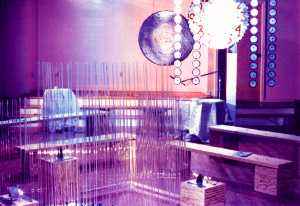
So after the 1970s, the nascent Expansion-Contraction Linear Modulation was subsumed into other ways of working, especially the use of ritualistic techniques begun in Plasm over ocean and Missa da Camera and continued in such compositions as Ash Wednesday (based on T.S. Eliot's poem) and in computer spaces like Nighthawk, or creations using arrays of sculptures and handmade instruments with computer assistance such as Echo, an hour-long solo performance work.
That ritualistic/performance stream was largely brought to fruition with In Bocca al Lupo, a sound/sculptural installation with twenty individual lines of natural and computer-generated sounds that could be heard in a spatial arrangement of initiation, overlap, and intensity that were driven by a computer algorithm. I created the algorithm to learn how visitors moved in the space in which the work was installed, and let it re-program its modules. This self-modifying software preserved its state each day in lithium-backed up memory, and eventually created a six-week history of its life. It was a crude but serviceable artificial intelligence written in 6809 machine code.
You can see photographs and hear sound clips from the 1985 Echo and 1986 In Bocca al Lupo, as well as Plasm over ocean, the surrealist Stoneworld/Grey, and various other installations and performance works on my website.
During a fallow period in the early 1990s, I began collecting a variety of pieces for publication, and it was then that I finally had the revelation that I indeed had something of a style, or at least a consistency, most apparent in the long orchestral movement Softening Cries.
I immediately distilled the style and composed a series of miniature duos that consciously explored it; first called Seven ECLM Studies, which I soon forsook in favor of Seven Chocolate Eclems, these duets are little more than modulating pitch-canons at the unison or octave that show the technique's possibilities in a stark and skeletal manner. Having already developed the process unconsciously for nearly 20 years, writing the studies was actually an enjoyable journey through familiar sonic territory.
It's hard to know how a style develops. ECLM apparently arose out of the positive feedback loop between me and my audience -- even with electronic works, which I would send to an ever-growing mailing list of friends. They reacted, and I watched and listened. The music with the strongest ECLM content always evinced mystery or ambiguity or some unsettled but magnetic reaction. I imagined outfitting my listeners with new ears, and moved toward encouraging those unsettled reactions.
By the time I created Hypertunes, Baby for voice and tape in 1994; Xirx for electronics, ice, and aromas in 1996; and the sound installation Detritus of Mating in 1997, I not only had begun to use these ideas more consciously, but also was trying to break out of the restrictive walls I'd built around myself.
Detritus modulated dozens of parts through textures, colors, and tone centers, all extracted from the single set of original sounds, the timbres and tones of twenty numbers read in Czech. A full version of the piece (six channels on three CDs) takes 27 years to complete. The center of the work is a 100-voice canonical shape, originally imagined as I was writing my 1969 Composition for Tape & Soloists. The disguised canonical shape also plays a part in the thick fugal structures of the high-minimalist Mantra Canon for orchestra, chorus, percussion, two pianos, and descant soprano in 1986, and the atonal-minimalist piano solo Rough Edges of 1987.
The Detritus fugue does exactly what I'd hoped: it offers no clue to its formality, but rather suggests a massive and almost frightening mountain of sound.
Excerpt from the Detritus of Mating fugue [not yet available]
My interest in the linearity of sound through time, and the kinds of interactions and sonic continuities that would result, also brought me to create experimental sound installations. In the late 1960s, I was certain that electronics would expand the experience of music, but I was also convinced it would not be (at its heart) through mathematical structures or new musical organizations. Electronic experiment would result in music what was made personal.
This was and is very different from the prevalent view that electronics and computers offer more precision, more replicability, more choices, and more techniques. Those were important to me -- and still are -- but only as a means of achieving a personal, almost mystical, musical experience.
Achieving it also meant plunging into experimentation, from assembling tape pieces to building electronic gizmos, and learning how listeners would react to and interact with them.
I soon fell in love with artistic interactivity as an ongoing experience. This was before performance art had a name, before multimedia was misapplied to video screens, and before computers were a household appliance, so inventing any sort of transparent interactivity involved photocells and cables and batteries and analog circuitry and masses of technological crudities that had to be hidden from view ... as well as fruitless explanations on grant applications.
Interactivity meant integrating human experience rather that working outside it, or at best wresting it from the outside. In other words, I sought to minimize the technological feel and downplay the theory -- especially the ambiguous intellectual art of the avant-garde -- in favor of irrefutable connections to cultural commonalities, coupled with sensual ambiguity.
In the past 25 years, I've created a dozen or so installations and sound environments and, since these followed rather than participated in the Fluxus/avant-garde, their interactivity was far more involving than confrontational.
| 1973 Trans/Media Minifest (multi-channels and -media, soundscapes) 1975 CautionMergingEnvironments (death ritual, sound in the head) 1977 Plasm over ocean (return of ritual, surrounded audience) 1977 Stoneworld/Grey (surrealism and ritual, audience involvement) 1978 Rando's Poetic License (first use of interactive microcomputer) 1984 Nighthawk (computer control) 1985 Mirrorgarden (light and ritual in an open space) 1985 Echo (ritual, computers, and interactive multimedia) 1986 In Bocca al Lupo (intelligence and interactivity) 1987 TDev (not done -- a complete interactive civilization space) 1991 Wolf5/Traveler's Rest (memory interactivity and performance) 1997 Detritus of Mating (slow multichannel development) 1999 Zonule Glaes II (slow development with live performers) |
In the Trans/Media Minifest, an environment developed in collaboration with 15 artists, I built a series of sound corridors with multichannel layers of acoustic music on tape, light-sensitive roses that hummed and buzzed, delayed auditory feedback, and floor switches that played electronic sounds. It was a loud and crowded space.
By CautionMergingEnvironments two years later, the corridors had evolved into very subtle and private places, including high-intensity, supersonic tones that produced quiet, buzzing, resulting-tone artifacts in the listeners' ears. I found myself working with awareness born out of disorientation, very much part of a Zeitgeist that still embraced psychedelia and sensory deprivation tanks.
Plasm over ocean was not only a chamber opera with the characteristics I've already described, but also one where some performers traveled inside the audience; the surrealist Stoneworld/Grey extended it to active performance within and around the audience.
In 1978, Rando's Poetic License became one of the first interactive pieces ever to incorporate microcomputers, accepting audience text input and producing poetry-like output that was read and included in the performance. My experiments in interactivity had suddenly moved from the somewhat confrontational to the thoroughly collaborative.
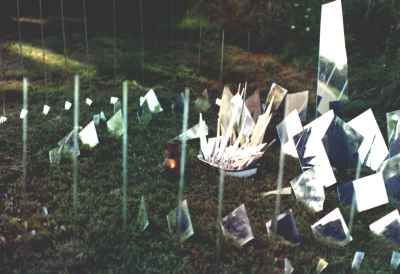
Now that I was using computers, I was also acutely aware that the passive place of the machinery needed to change, and with Nighthawk, I developed a sound space that changed as people walked through it. It was effective, but still cold and disappointing. I returned dramatically to ritual with Mirrorgarden, which used no machinery, only mirrors, oil lamps, the sun, the moon, water, shadows, and my singing voice.
I was in full artistic crisis, having passed through all of 1984 without a single composition. I tried to resolve the dichotomy of machinery and humanity, silicon precision and bodies & brains with their 10-millisecond delay from eardrum to brain, and many milliseconds more from brain to hand, during which my crude computers could perform thousands of operations. How could such crystalline precision be molded around the human form?
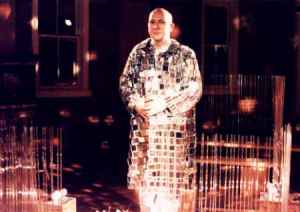
Finally with the 1985 Echo, I found that I could interact with both the computer space and the audience, effectively become the audience's extension into the silicon interaction, along with handmade instruments, sculptures, lights, and my voice. It was a very powerful and disturbing experience, especially for me, who to this day is uncomfortable as a performer. The success of Echo inspired a collaboration with sculptor Fernanda D'Agostino, one of the original participants in the Trans/Media Minifest 13 years before. In the intervening decade, she had independently developed a sculptural concept of invented societies. Her abstractions of roadside shrines dovetailed perfectly with my interactive sonic inventions. In 1986 we developed In Bocca al Lupo, a living space wherein her sculptures contained my sound projectors and sensors. The software learned the space, and transformed itself over six weeks as her sculpture stood consistent, immutable.
Money intervened, and the planned subsequent installation, TDev, was never funded, a great disappointment because it was to incorporate all the senses into the interactivity, not only sound. Five years passed until 1991's Traveler's Rest became an outdoor re-thinking of the concept, whereby visitors moving through a field and collection of buildings and artifacts would become part of the experience others would have in the future -- in other words, their sounds would be recorded and mixed and transformed, appearing to later visitors as part of their environment.
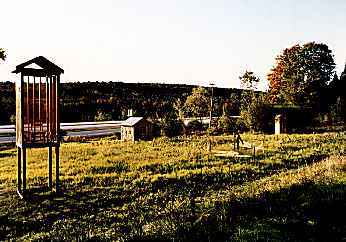
Unfortunately, the outdoor installation was vandalized within days, sculptures stolen and computer equipment destroyed. In its place, I created the performance work Wolf5, which condensed these events into a single piece. It remains in unedited video form, abandoned when I left for Europe to spend time in its atmosphere of theory and abstraction.
I've come to an interesting resolution with Detritus of Mating, created for the sculpture of Pavel Kraus, and its successor, Zonule Glaes II, now in composition*. Detritus has received some criticism, not least of which from electroacousticians who feel its use of the simplest tools of filtering, stretching, and resynthesis is 'retro'. In technological terms, it is. But I have always preferred to speak in communicative terms, in experiential terms, and actually evaluate my experiments -- not simply propose, execute, and abandon.
Just a few days ago, Michael Frengel was a guest on Kalvos & Damian, and he spoke about a return from a kind of unformed shape to a concern for formalism, particularly because computerized tools now permit us to realize concepts we had not been able to bring to life with human or analog approximations.
I was surprised and pleased, since Brian Eno had recently written about the disconnection between our computer interfaces and our human ones. He said, "I'm struck by the insidious, computer-driven tendency to take things out of the domain of muscular activity and put them into the domain of mental activity. This transfer is not paying off. Sure, muscles are unreliable, but they represent several million years of accumulated finesse. Musicians enjoy drawing on that finesse (and audiences respond to its exercise), so when muscular activity is rendered useless, the creative process is frustrated."
He continues, "When you use familiar tools, you draw upon a long cultural conversation -- a whole shared history of usage -- as your backdrop, as the canvas to juxtapose your work. The deeper and more widely shared the conversation, the more subtle its inflections can be."
Eno is showing his age, and Frengel is right on the mark. And throughout my installations, I've had the related philosophy that the Simplest Way -- the greatest elegance of 'feel' though not necessarily 'solution' -- was the most successful in drawing an audience to art without compromising its heart. It's how Bernstein described the conclusion of the first movement of Beethoven's Fifth Symphony: After all the compositional complexities, the most powerful ending was the simplest.
I agree. Even with the reams of software, spools of wire, clusters of sensors, hidden speakers, and five interconnected computers, the only part of In Bocca al Lupo that remains important is its simple interaction with basic human fears and dreams -- its dark, light, muscularity, and sound.
That brings me back to eclecticism and mediocrity, and the purpose of music -- particularly experimental music -- as this strange century ends. It's my ongoing internal debate over the validity or purpose of 'experimental' music.
I would hope I'm not the John Tesh of the aging avant-garde, with talk of listeners' concerns over tools and technique. I have always felt that whether it was confrontational and provocative, or sensual and evocative, music has a fearful depth that could let the saints be ecstatically transformed as they were pierced by arrows, or terrorize a Stalin and Pinochet enough to have them seek and murder their composers.

Manfred Clynes is convinced that there are pan-human musical gestures, and I agree with the sense of that, if not the details. In fact, my wife Stevie Balch and I presented a paper to the first World Congress on Arts Medicine proposing that music can serve as a replacement for lost verbal language -- music as a different kind of language, not on its own terms.

Composer John McGuire said to me that he sees his process of composition as 'solving problems'. This bothers me. It seems a kind of bloodlessness, and I'm not convinced he speaks the truth about it himself. Perhaps the genesis of a piece is a problem, or the process of driving it to completion presents obstacles, but 'problem to be solved' has the false patina of an experimental music that really doesn't follow the course of experiment.
In other words, composers of experimental music in general have not presented a hypothesis, offered evidence, followed a process of testing, and drawn a conclusion that revealed their success and failure. That's not really experimental at all*, and, except for theoretical exercises, it doesn't solve musical problems, much less problems outside a circumscribed sonic world.
In 1991, musicologist Leigh Landy wrote a book called What's the Matter With Today's Experimental Music? He failed to make a case for defining experimental music, equating experiment with indeterminacy, and dismissing all other music that will always be "a large ... part of our musical landscape" as prizing "craftsmanship above innovation."
I don't believe music offers many problems to be solved, but neither is it mainly a personal expression, a cry of anguish, or a shout for joy. It's my turn to be cold-blooded. Cries and shouts are emotional components, as much building blocks of music as tonality and texture and melody and gesture. But music that is driven by such personal expression alone is a kind of masturbation -- pleasurable or necessary, perhaps, but rarely art.
On the other side of this question, and the one that confounds me, is the idea that music is communication. I want to believe this, but communication with whom? Why? How -- with what means and most important, with what language?
This makes me brood. In my quest to create a weave of linear sounds, I have written some extremely complex music that sometimes bewilders audiences. Softening Cries is an orchestral work -- the second movement of a projected Symphony No. 4 -- that includes multiple arches of sound that never stop over a period of twenty minutes. With each listening, one can focus on certain lines or sets of lines, but how much can be heard at one time? What is the point of contact with a piece that cannot be heard in its entirety? How much of it matters? Why did both musicians and audience like it?
This is my experiment: to push the borders of 'hearability' and use the evidence of my audience's reaction, interaction, and feedback to validate each experiment. It's as close as I can get to scientific experiment, even if it can be fairly described, in Landy's phrase, as "craftsmanship above innovation." But the era of experiment-as-indeterminacy is coming to a close, in much the way that Frengel has brought his rhythmic studies under a kind of digital scrutiny: experiment-as-determinacy.
And now -- another dilemma -- if compositions are doomed to be heard only once in our America, should we strip them down, simplify the experiment, if only to make it possible at all? Certainly I hope that our listening skills will evolve to include that multi-threading, to make Softening Cries as easy to hear 'through' as a Bach cantata.
At times, my hope for this evolution is terribly weakened.
Four years ago, composer David Gunn and I were given the opportunity to fill in a 90-minute weekly radio slot at WGDR in Plainfield, Vermont, and we invented Kalvos & Damian's New Music Bazaar. The idea was to give Vermont composers a chance to be heard with interviews and music.
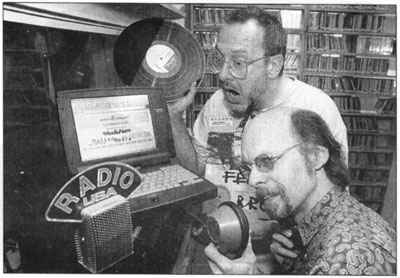
The show was a local hit, and at the end of the summer, we were invited to expand it to two hours, and simultaneously given access to Goddard College's web server, where we immediately created a site with music and interview clips. Since then, Kalvos & Damian has broadcast 195 shows, including 140 interview programs with 97 composers from the United States, Canada, Germany, France, Belgium, and the Netherlands.
We've been live on the Internet for a year, and most of our past shows can be heard in on-line archives. Last September we did a groundbreaking live concert in a bi-directional cybercast interview with Damian in Vermont and Kalvos in Amsterdam, mirrored on the Internet in the Netherlands, Vermont, and California, and using a high-quality Internet feed for broadcast from WGDR.
Those of you who are composers are invited to join us on the program. Jody Diamond, Larry Polansky, Jon Appleton, and as I've mentioned, Mike Frengel have been on the show. Our goal at K&D is both to humanize composers -- alien critters in American life -- and to present music in a kind of buffet, a sampler, with lots of humor and strong opinions. We've run up against some very hostile composers who feel we're the worst possible kind of deejays for so-called 'classical music' with our snipping and sniping. Based on that experience, we've given the show a motto: Your Red Alert for New Music.
We have a loyal audience, but a split one. Here's one letter we received last week:
I will long remember the Saturday morning back in October of 1997, a morning of surfing the net, visiting different radio station sites, both public and commercial, finding nothing but endless chatter on topics I couldn't care less about, sports I couldn't even care less about, music of which I had heard too many times, then ... I stumbled across a site from somewhere called Plainfield, Vermont. I found WGDR-FM and your show. I have been a loyal listener ever since. It's been a total breath of fresh air listening to all these talented Vermont composers and their work, and I can never get enough Raymond Scott. Long live Kalvos and Damian!
That's the kind of fan mail we like very much, but we've also discovered a split audience: those already enthusiastic about new music, and those who are less than clueless. We can do little for the clueless but entertain, and if we can keep their attention, we've done our job. We've put sounds in their ears. And it seems we have done that job, generating calls and mail from listeners who have never heard the kinds of sounds we play.
But those enthusiastic about new music can be just as startling. We did three overnight programs a few months ago: chamber, orchestral, and electronic/electroacoustic. The only show to generate phone calls was the last, similar to George Todd's interview two years ago, which still holds the record for enthusiastic callers.
On the other hand, audience requests always tend toward those I might describe as easy-listening composers. Does Michael Torke's success, for example, mean the 'experiment' of new music is failing? Or that it has been sent back for re-hypothesizing?
Our marketing-driven world, where the great state-sponsored orchestras of Eastern Europe now play the highest bidder music-trivia, provokes me to ask myself regularly, "What happens when I am 'out there' composing?" Entertainment is wonderful, but it's certainly not what I do. And I think I can prove that with three anecdotes about misunderstanding. Misunderstanding is not limited to listeners, nor is failure of the experiment difficult to discover.
The first story takes place in Amsterdam. Under the influence of the Dutch algorithmic composers, I began writing an orchestral composition based on the pitches and rhythms of a dripping faucet that was keeping me awake. I began with a complete Markov analysis of the original sounds, developed a series of melodic streams, and began weaving them into a composition. This Dripworks piece seemed eminently valid to me, a fascinating study in inverted orchestration, long intertwined lines in a variety of microtonal relationships, and contrapuntal instrumental choirs. It was also a complete failure in discovering any purpose in itself. I had hugely misunderstood the listener, almost any listener. It's a book in itself: The Composer Misunderstands. After 40 pages, I abandoned Dripworks.
Brand 9 from Outer Space was conceived as a short, broken tango, with a quick rhythmic pulse -- an enjoyable melody-harmony trinket of the sort I tend to avoid ... but I don't turn down many paid commissions! In New Orleans, Lucius Weathersby and his ensemble at Dillard University found the on-line score and asked to premiere the piece. As you might expect, I readily agreed. When Lucius, a consummate musician with a wonderful sense of expression, sent me the recording, I was stunned. This humorous dance trifle had been turned into a passionate artifact of the Romantic era. Volume 2: The Performer Misunderstands.
Original concept of Brand 9 from Outer Space
Performance premiere of Brand 9 from Outer Space
The final story involves a work commissioned for chamber orchestra, Yçuré. In rehearsal, the ensemble hated it. They didn't understand it, didn't hear its musicality, and the conductor -- new to orchestral direction -- was stymied by how to communicate its architecture to the musicians. Had those been the only problems, it would have been a lackluster performance. Instead, the musicians took the offensive. During one rehearsal, they had a 'food fight' with crumpled up parts. One performer walked out for good. At the dress rehearsal, they wouldn't speak to me to the point of getting up from the table when I joined them for lunch. Rearranging the chairs for the premiere was left to me as I shuffled them around in front of the waiting audience. Some players wouldn't even move so I could stage-hand around them. During the premiere itself, the first violinist was laughing aloud, and the second oboist put down her instrument a few measures into the performance and never picked it up again. Volume 3: Misunderstanding as a Way of Life.
Where is your patron saint of mediocrities going with this? Toward being a composer who coalesces studies and ideas, driven to answer the confusing question of communicating with an audience, a living audience. In my day jobs as librarian, landscaper, editor, truck driver, pressman, secretary, graphics designer, store clerk, typist, repair technician, music teacher, writer, consultant, choir director, I have found our audiences want our sounds, not the sound of our labors.
February 17, 1999
May 20, 1999
| Malted/Media Home Page | http://maltedmedia.com/ |
| My Home Page | http://maltedmedia.com/bathory/ |
| My Catalog of Music | http://maltedmedia.com/people/bathory/cat-index.html |
| Kalvos & Damian's New Music Bazaar | http://maltedmedia.com/kalvos/ |
| Vermont Contemporary Music Ensemble | http://vcme.org/ |
| Vermont Composers Consortium | http://maltedmedia.com/consort/ |